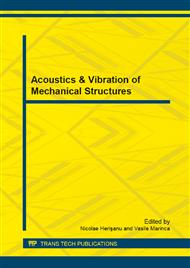[1]
R.A. Ibrahim, Recent advances in nonlinear passive vibration isolators, Journal of Sound and Vibrations 314 (2008) 371-452.
DOI: 10.1016/j.jsv.2008.01.014
Google Scholar
[2]
D. Sado, M. Pietrzakowski, Dynamics of thermally activated shape memory alloy autoparametric systems with two pendulums, International Journal of Non-Linear Mechanics 45 (2010) 859–865.
DOI: 10.1016/j.ijnonlinmec.2009.11.014
Google Scholar
[3]
A. Souza de Paula, M.A. Savi, F.H.I. Pereira-Pinto, Chaos and transient chaos in an experimental nonlinear pendulum, Journal of Sound and Vibration 294 (2006) 585–595.
DOI: 10.1016/j.jsv.2005.11.015
Google Scholar
[4]
S. -T. Park, T. -T. Luu, A new method for reducing the natural frequency of single degree of freedom systems, Journal of Sound and Vibration 300 (2007) 422–428.
DOI: 10.1016/j.jsv.2006.08.017
Google Scholar
[5]
N.D. Anh, H. Matsuhisa, L.D. Viet, M. Yasuda, Vibration control of an inverted pendulum type structure by passive mass–spring-pendulum dynamic vibration absorber, Journal of Sound and Vibration 307 (2007) 187–201.
DOI: 10.1016/j.jsv.2007.06.060
Google Scholar
[6]
S. -T. Wu, Y. -R. Chen, S. -S. Wang, Two-degree-of-freedom rotational-pendulum vibration absorbers, Journal of Sound and Vibration 330 (2011) 1052–1064.
DOI: 10.1016/j.jsv.2010.09.028
Google Scholar
[7]
S. Singh, S. Mukherjee, S. Sanghi, Study of a self-impacting double pendulum, Journal of Sound and Vibration 318 (2008) 1180–1196.
DOI: 10.1016/j.jsv.2008.05.001
Google Scholar
[8]
J. Warminski, K. Kecik, Instabilities in the main parametric resonance area of a mechanical system with a pendulum, Journal of Sound and Vibration 322 (2009) 612–628.
DOI: 10.1016/j.jsv.2008.06.042
Google Scholar
[9]
A. Alasty, R. Shabani, Chaotic motions and fractal basin boundaries in spring-pendulum system, Nonlinear Analysis: RealWorld Applications 7 (2006) 81 – 95.
DOI: 10.1016/j.nonrwa.2005.01.003
Google Scholar
[10]
K. El Rifai, G. Haller, A. K. Bajaj, Global dynamics of an autoparametric spring–mass–pendulum system, Nonlinear Dynamics 49 (2007) 105–116.
DOI: 10.1007/s11071-006-9116-y
Google Scholar
[11]
R. Bhattacharyya, Behavior of a Rubber Spring Pendulum, Journal of Applied Mechanics, 67 (2000) 332-337.
Google Scholar
[12]
N. –D. Stănescu, Mechanical Systems with neo-Hookean Elements, Stability and Behavior, LAP, Saarbrücken, (2011).
Google Scholar
[13]
N. –D. Stănescu, L. Munteanu, V. Chiroiu, N. Pandrea, Sisteme dinamice. Teorie şi Aplicaţii, Editura Academiei Române, Bucureşti, 2007, 2011, (2013).
Google Scholar
[14]
P. Teodorescu, N. –D. Stănescu, N. Pandrea, Numerical Analysis with Applications in Mechanics and Engineering, Wiley, Hoboken, (2013).
Google Scholar


